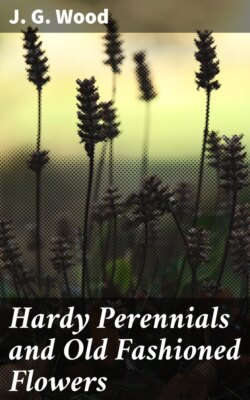Читать книгу Hardy Perennials and Old Fashioned Flowers - J. G. Wood - Страница 43
На сайте Литреса книга снята с продажи.
ОглавлениеFig. 20. Bocconia Cordata. (About one-twentieth natural size; blossom, one-half natural size.)
The leaves are from 8in. to 10in. in diameter, the largest being at the base of the tall stems; their outline, as the specific name implies, is heart-shaped, but they are deeply lobed and dentate, in the way of the fig leaf, but more profusely so; they are stalked, of good substance, glaucous, nearly white underneath, which part is also furnished with short stiff hairs. The glaucous hue or farina which covers the leaf-stalks and main stems has a metallic appearance, and is one of its pleasing features as a decorative plant. For many weeks the flowers continue to be developed, and from the deciduous quality of the fading parts, the panicles have a neat appearance to the last. In a cut state the long side branches of flowers, more than a foot long, are very effective, either alone or when mixed with other kinds, the little clusters of white drop-like buds being suitable for combination with the choicest flowers.
As a decorative specimen for the more ornamental parts of the garden, and where bold subjects are desired, there are few herbaceous things that can be named as more suitable; from the day it appears above the ground, to and throughout its fading days in the autumn, when it has pleasing tints, it is not only a handsome but distinct form of plant; as an isolated specimen on the lawn, or by frequented walks, it may be grown with marked effect; if too nearly surrounded with other tall things, its beauty is somewhat marred; but wherever it is planted it should have a good fat loam of considerable depth. I ought not to omit saying that it forms a capital subject for pot culture; plants so treated, when 12in. or 18in. high, no matter if not then in flower, are very useful as window or table plants; but of course, being herbaceous, they are serviceable only during their growing season; they need not, however, be a source of care during winter, for they may with safety be plunged outside in a bed of ashes or sand, where they will take care of themselves during the severest weather.
It may be propagated by cuttings taken from the axils of the larger leaves during early summer; if this method is followed, the cuttings should be pushed on, so that there are plenty of roots before the winter sets in. I have found it by far the better plan to take young suckers from established plants; in good rich soil these are freely produced from the slightly running roots; they may be separated and transplanted any time, but if it is done during summer they will flower the following season. Tall as this subject grows, it needs no supports; neither have I noticed it to be troubled by any of the garden pests.
Flowering period, September to August.
